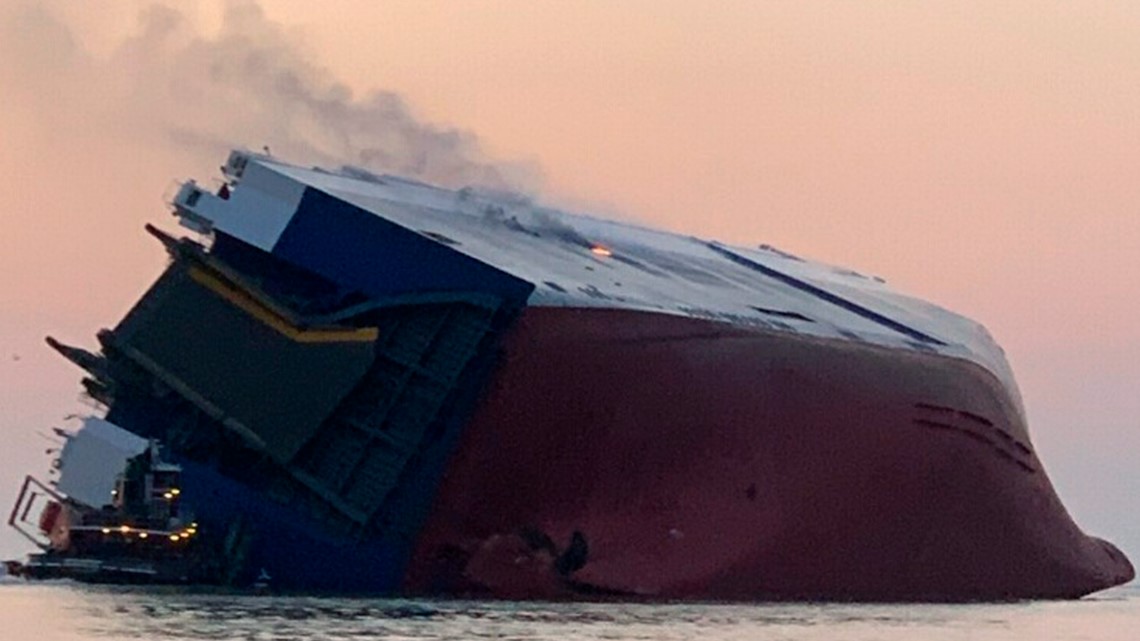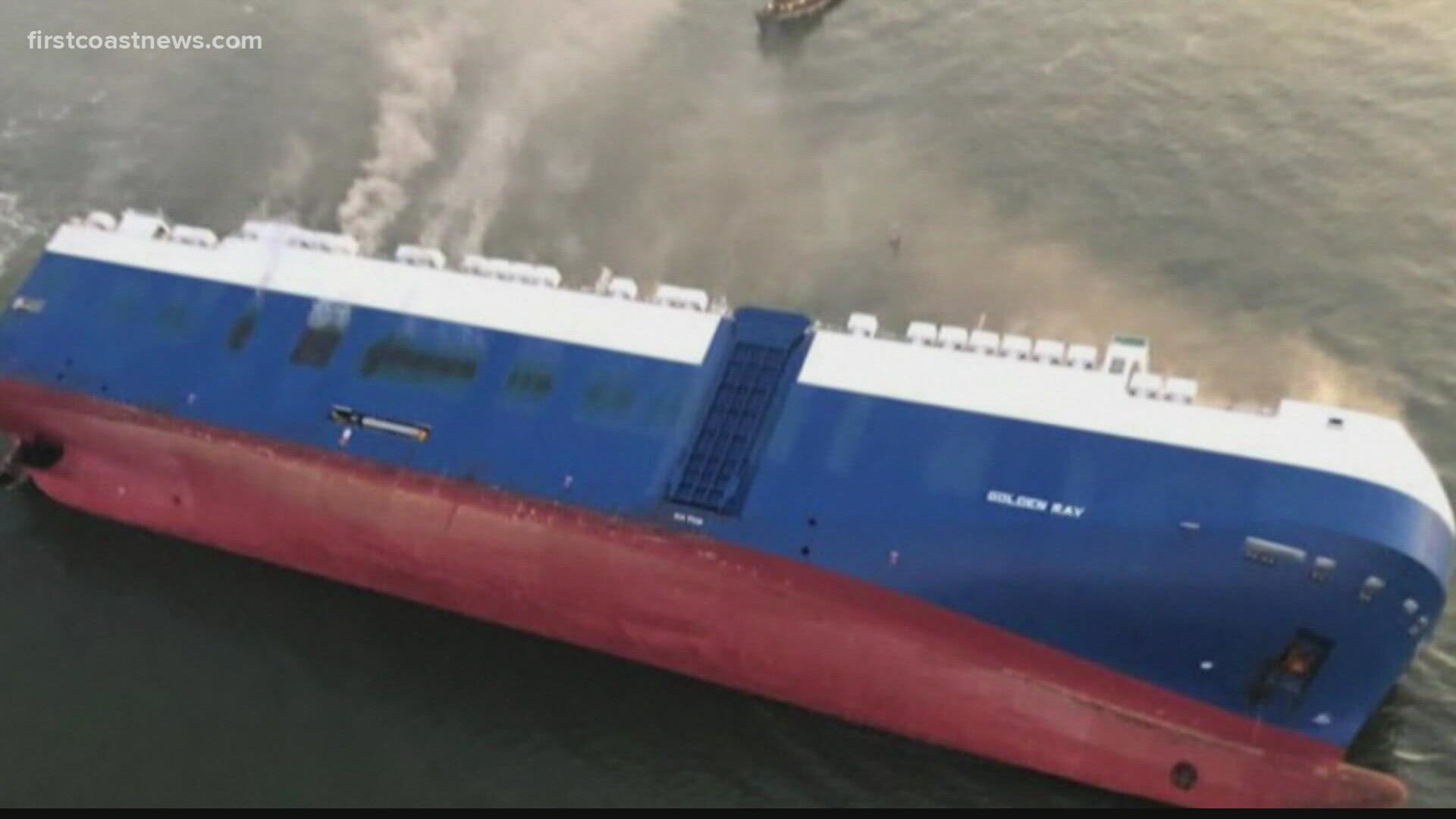ST. SIMONS ISLAND, Ga. — Almost every day for the past two years, Captain Andy Jones has gone searching for something he hopes he doesn’t find.
Pollution -- from the Golden Ray.
The 8th generation St. Simons Island native has been documenting the cargo ship disaster from the morning it capsized Sept. 8, 2019. As the sun broke over the horizon, he piloted his boat, the Minorcan Mullet, into the sound.
“We rounded the corner, and yeah: There was a ship on its side,” he recalls. “It was a bit shocking, especially to understand there were people trapped in there.”
The rescue effort that followed seemed almost miraculous -- all 24 people aboard survived.
But the subsequent salvage operation hasn’t been so fortunate. During the nearly two years the ship has languished off the Georgia coast, it has been plagued by oil leaks, one massive fire and multiple equipment failures. It’s also been delayed by COVID, hurricane season and what the U.S. Coast Guard gently dubbed “engineering problems.”
The result is a project that is more than a year behind its original completion date and months behind even recalculated deadlines. It’s also hundreds of millions of dollars over budget, according to industry experts, and is now on track to be the most expensive ship salvage operation in history.
What happened?
The trajectory of the Golden Ray from the time it left the Port of Brunswick to the present day is so multilayered it might be called the Golden Ray Experience.
The initial catastrophe was caused by teetering instability, a combination of ballast discharge at sea and cargo shift in port. The blame for that has yet to be assigned – the Coast Guard and the National Transportation Safety Board have yet to issue formal findings. But the outcome was pretty clear: The two-year-old ship and its 4,200 vehicles were a total loss.
St. Simons residents don’t need binoculars to see the results. And they’ve largely learned to live around the wreck. There’s even a cottage industry of T-shirts, featuring the beached craft and the words, “Ship Happens.”
But that doesn’t make the reality of the rusting, polluting shipwreck palatable. When the plan to cut the ship into eight pieces was announced in February 2020, the Unified Command – composed of the Coast Guard, the Georgia Department of Natural Resources and the “Responsible Party” (ship owner Hyundai Glovis and its insurer, North of England P&I Club) -- said it would be completed before hurricane season, in June 2020. Cutting didn’t begin until November 2020, but even then, the Unified Command said it would still take just eight weeks to complete. Twenty-four hours for each cut. Done before New Year’s Day.
The Coast Guard and the salvage company, T&T Salvage, now acknowledge the 24-hour estimate was – well, optimistic. Some cuts have taken months to complete.
But maritime salvage experts contend the original estimate was unrealistic from the start.
“It’s just completely implausible,” says Paul Hankins, director of operations for the Navy Sea Systems Command’s Supervisor of Salvage & Diving, and former VP of Salvage for Donjon-SMIT.
“Now, everybody now knows that it was ridiculous because everybody has seen what happens when you try to do these chain cuts. But back then, certainly all the salvors knew that that was ridiculous.”
It was, paradoxically, the promise of speedy completion that was the reason the original salvage contractor, Donjon-SMITT, was ultimately replaced by T&T Salvage.
The decision to change contractors midstream has been the source of enormous controversy in the maritime world. Opening the project to bidders arguably delayed the process, as the contract was negotiated and the new salvage machinery brought on site.
But it was the precedent set by the change that most worries some observers.
Captain John Konrad, a master mariner, author and founder of the maritime blog GCaptain.com, says by allowing the ship owner and insurer to re-bid the contract, the Coast Guard undermined the Oil Pollution Act of 1990.
“OPA 90” as it’s known in the salvage world, is the federal law created following the Exxon Valdez disaster in 1989. It requires, among other things, that all vessels operating in U.S. waters have an emergency responder under contract in the event of an accident.
The reason is simple, Konrad says. The same reason cities don’t wait for buildings to burn before they hire firefighters. “It’s an emergency.”
Donjon-SMIT was that emergency contractor for the Golden Ray. And their early work was a success. Staff was on site within two hours, and crews began working to extinguish an on-board fire soon after that. It was Donjon-SMIT employees, with Coast Guard oversight and help from other crews, that ultimately rescued four trapped crew members, cutting through the hull to deliver food, water -- and eventually a ladder -- to the men inside.


“SMIT is probably the best salvage company in the world,” Konrad says. He notes it was the contractor summoned to the Suez Canal in March to unstick the Ever Given – a container ship twice as big as the Golden Ray. “They needed the best,” he says. “They got the best.”
Konrad says changing salvage companies midstream is irregular and “pretty much illegal” under OPA 90. “But the Coast Guard has overriding authority,” he says, “and somehow they got an exception to this rule.”
After Donjon-SMIT was replaced, the company sued the Coast Guard in February 2020, alleging the agency was “in direct violation of the OPA 90 … [in] permitting an extremely high-risk salvage plan.” The complaint continued, “the whole point [of the law is] …to prevent having to put everything on hold… while the salvors negotiate a contract.”
In response, the Coast Guard said it lawfully deviated from OPA 90 because they have the discretion to “authorize deviation … where exceptional circumstances exist.” Those “exceptional circumstances, according to the Coast Guard’s filing, were threefold:
- The vessel is very large (656 feet in length) and in very close proximity to a navigable channel that is the sole access route to the one of the busiest ports in United States -- the Port of Brunswick
- The vessel is grounded in an environmentally sensitive area that includes prime shrimping grounds and a significant roosting area for migratory birds
- The vessel is aground in close proximity to the major tourist destinations of Saint Simons and Jekyll Islands
The court rejected Donjon-SMIT’s request for an injunction to stop the bidding process and the company ultimately abandoned the lawsuit. Konrad says it was a seminal moment in the Golden Ray saga.
“They were allowed to accept the other bids, the bids came out with this dangerous plan that T&T Salvage is doing now, it was approved -- and right away, it was a huge delay factor,” he says. “And you got to understand the longer it's there, the harder it gets. Things rust, things fall apart, machinery breaks, it sinks down deeper. So just the delay made it a lot harder.”

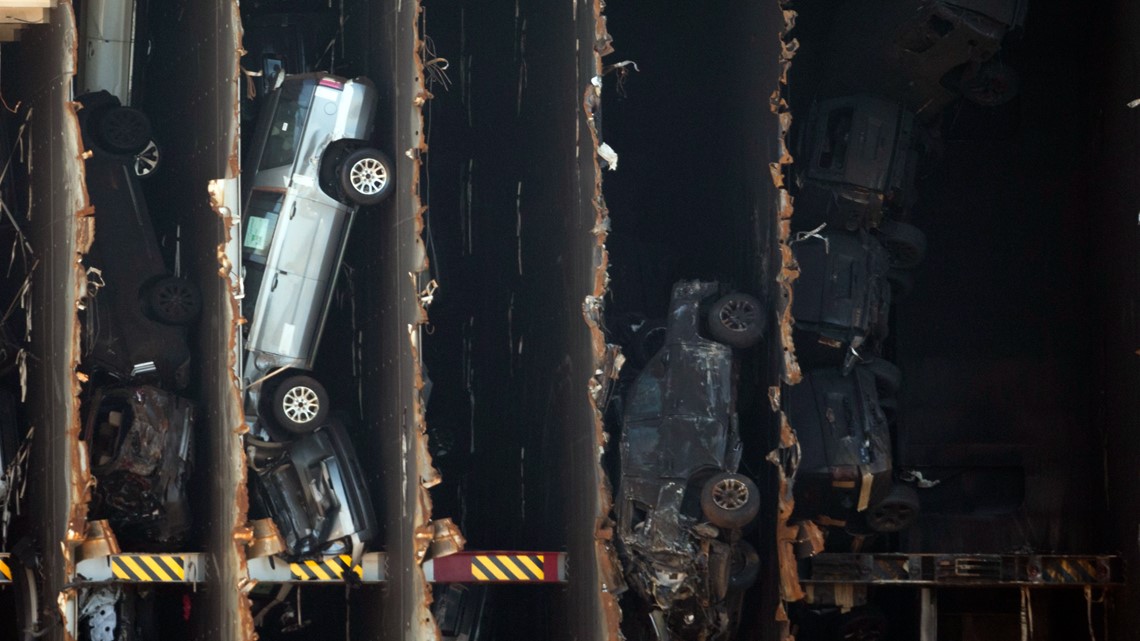
Who Knew?
The choice to go with T&T Salvage was based on the company’s plan for a “large section removal.” This approach involved using a steel chain to slice the ship into sections and hoist each one onto a barge for removal.
According to the ship owner and its insurance company, large section removal was the “preferred option,” since they believed it could be accomplished quickly.
It’s an approach Donjon-SMIT considered, but rejected. According to Hankins, they knew better.
“We tried that method, and it failed,” he explains. The company attempted large scale removal in two earlier car carrier salvage projects – the Tricolor and the Baltic Ace. Because cargo ships have limited interior structural integrity – Hankins compares them to a floating parking garage – they eventually fell apart.
“There’s so little structural integrity inside these ships. It’s essentially a big shoe box. And when you cut the ends off, which is where the strength of the ship is, the tendency was for the middle of the ship basically to collapse.”
The other reason they disliked that approach, he says, was the pollution risk.
“The whole reason for doing this was to prevent pollution from entering St. Simons Sound,” he says. “As soon as you cut into that hull with a chain, any pollution that's inside that hole is going to leak out.”

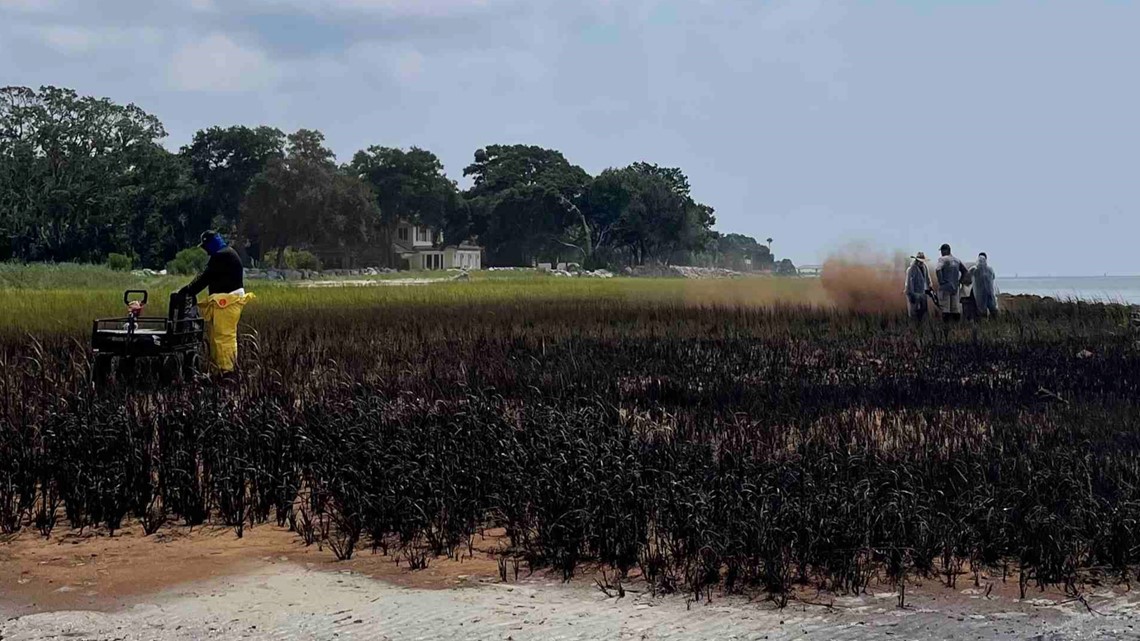
Donjon-SMIT favored a small-scale removal. They proposed removing ship’s starboard side – essentially the “top” of the downed vessel – then gutting its interior, removing the vehicles inside in small sections while leaving the hull intact.
“It’s essentially a bathtub,” Hankins explains. “Everything inside is contained.”
The large-scale removal plan included an environmental barrier built around the wreck to contain pollution and debris. In theory, it would contain the impacts of sawing the ship into pieces. In practice, the barrier has not prevented quantities of heavy oil and debris as large as tires and bumpers from routinely washing up on nearby beaches.
Just last weekend, removal of the sixth section generated the third "significant" oil discharge, creating a veritable river from ship to shore, blackening the famed Golden Isles and tainting more than two miles of Brunswick area beaches.
You don't have to be a maritime ship expert to realize that this plan is terrible.” Konrad says. “This was a car carrier! They’re cutting through cars, through gas tanks, antifreeze lines, hydraulic lines, it's a conglomeration of all the sh*t that you're putting into a car.”

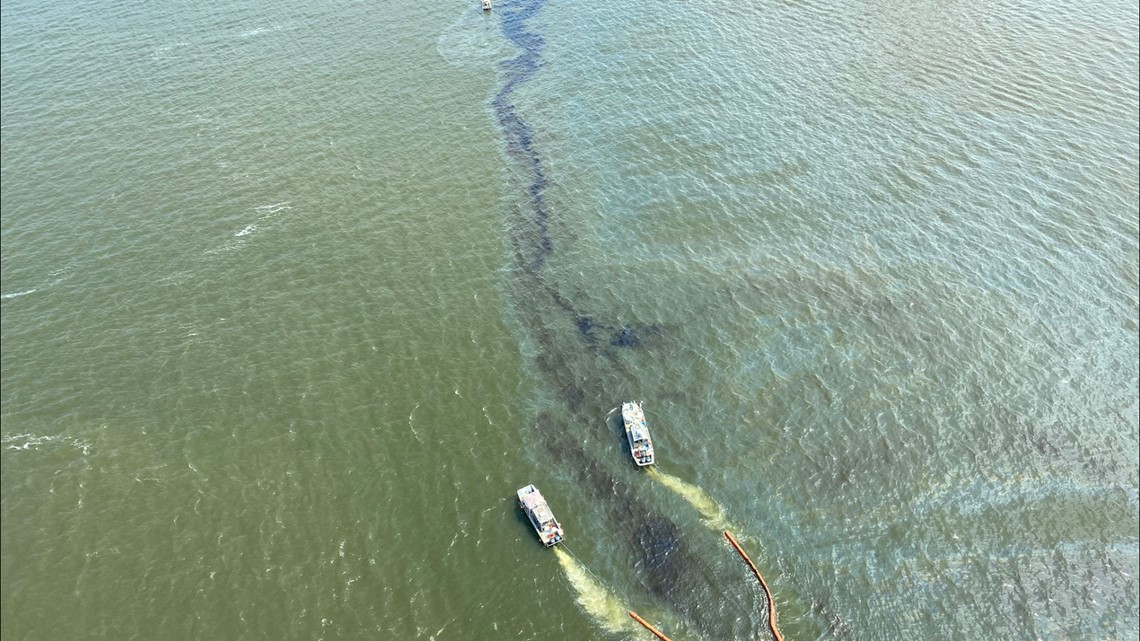
Hankins says the environmental barrier, though well intentioned, is undermined by currents in St. Simons Sound.
“I use this analogy of a washing machine,” he says. “You have this high flow going through. So any transmission fluid oil, piece of the cars, whatever: If it gets in that current, it's going to get entrained. And when you entrain oil and water, that means it's not floating on top, it's just all mixed up. And it goes out into the water column.”
T&T Salvage referred questions about the project to the Unified Command under the Coast Guard.
The ship’s insurer, the North P&I Club, said that its role in the salvage operation – including the contractor and the removal method selected -- is limited. A representative told First Coast News, “Most of what is happening is being dictated by the Coast Guard,” adding, “the ultimate decision makers are the federal and state authorities.”
Coast Guard spokesman and Petty Officer 2nd Class Michael Himes says large section removal “fit the safety, environmental protection and port functionality priorities” of the project, and says environmental barrier has been shown to work. As for any delays the bid process may have caused, he says it was just one of myriad delays the project has encountered, and hardly the most consequential. “To suggest that a faster way was possible AND fit our priorities is speculation at best.”
How Much?
The Costa Concordia disaster was costly in ways that cannot be measured.
Thirty-two people died after the cruise ship’s captain crashed into rocks off the west coast of Italy, causing it to capsize and sink.
But aside from the human toll, it was also the single most expensive ship salvage operation in history.
Until now.
According to industry publication The Insurer, in February 2021, the price tag for the Golden Ray salvage stood at $800 million – and that was before the substantial cost of fighting the conflagration in May. The project is now expected to top $1 billion – the Costa Concordia’s price tag.

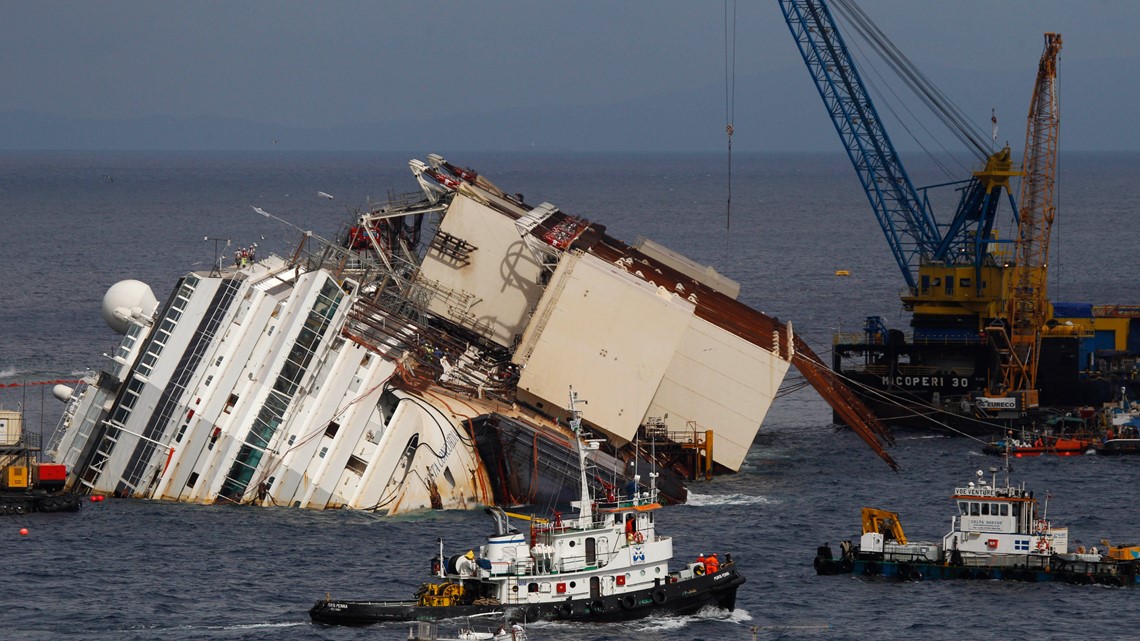
The Golden Ray’s primary insurer is North of England P&I Club, one of 13 “Protection & Indemnity” clubs, which cover liability for about 90 percent of the world’s ships. The P&I clubs will collectively shoulder monumental cost of the Golden Ray, not taxpayers.
But it’s not just the price tag that is eye-popping, it’s the degree of miscalculation.
According to sources familiar with the bid process, Donjon-SMIT and T&T Salvage each proposed project costs between $100 million and $200 million. Though some cost overruns attach to the chosen project – the fire, broken cutting chains – it’s impossible to extricate those early estimates from the delays that have plagued the project, including storms and the pandemic.
Coast Guard spokesman Himes says, “it makes me a little skeptical that some people try to paint an alternative reality. To say that was a better faster way to do this that would have fit all the priorities -- that’s not the world we are in. It’s almost like a thought experiment.”
Hankins contends the project should have been done long ago, but agrees there is nowhere to go but forward. “You can't put the genie back in the bottle at this point.”
Ray McKelvey, the project’s Environmental Response manager, says given the many challenges, things are going as well as could be expected. “It’s a tough job,” he says. “I think with this the size, and the fact that nobody's ever done a project like this before I really feel that we're, in my opinion, keeping them moving along safely and doing the best we can to prevent a bigger catastrophe.”
With hurricane season underway, that goal is something on which everyone agrees.
“We just want them to finish,” says Capt. Andy Jones. “The best-case scenario we can hope for now is for the ship is removed as quickly as safety will allow.”

